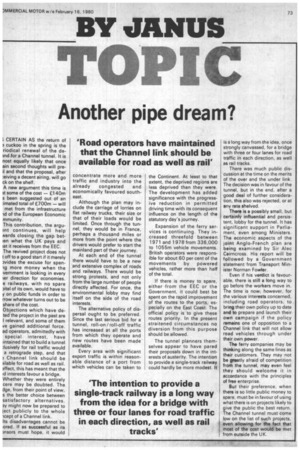Another pipe dream?
Page 75

If you've noticed an error in this article please click here to report it so we can fix it.
'Road operators have maintained that the Channel link should be available for road as well as rail'
; CERTAIN AS the return of .3 cuckoo in the spring is the riodical renewal of the demd,for a Channel tunnel. It is nost equally likely that once am n second thoughts will preii and and that the proposal, after :eiving a decent airing, will go ck on the shelf.
A new argument this time is it some of the cost — £140m s been suggested out of an :imated total of £700m — will met from the infrastructure Id of the European Economic mmunity.
This contribution, the argu3nt continues, will help. Nerds closing the gap bet!en what the UK pays and iat it receives from the EEC. The revived project does not
t off to a good start if it merely avides the excuse for spenig more money when the vernment is looking in every ier direction for economies. e railways, with no spare )ital of its own, would have to y on public funds in order to rrow whatever turns out to be share of the cost.
Objections which have doted the project in the past are I relevant, and some of them ire gained additional force. ad operators, admittedly with special interest, have [intained that to build a tunnel ;lusively for rail traffic would a retrograde step, and that 3 Channel link should be ailable for road as well as rail. affect, this has meant that the id interests favour a bridge. Whether they were entirely cere may be doubted. The dge, from their point of view, s the better choice between satisfactory alternatives. 3y might now be prepared to ject publicly to the whole icept of a Channel link.
Its disadvantages cannot be ored. If as successful as its )nsors must hope, it would concentrate more and more traffic and industry into the already congested and economically favoured southeast.
Although the plan may include the carriage of lorries on flat railway trucks, their size or that of their loads would be limited. Once through the tunnel, they would be in France, perhaps a thousand miles or more from the point where the drivers would prefer to start the mainland part of their journey.
At each end of the tunnel there would have to be a new and extensive complex of roads and railways. There would be strong protests, and not only from the large number of people directly affected. For once, the environmental lobby may find itself on the side of the road interests.
The alternative policy of dispersal ought to be preferred. Since the last serious bid for a tunnel, roll-on / roll-off traffic has increased at all the ports from which they operate and new routes have been made available.
Every area with significant export traffic is within reasonable distance of a port from which vehicles can be taken to the Continent. At least to that extent, the deprived regions are less deprived than they were. The development has added significance with the progressive reduction in permitted driving time with its consequent influence on the length of the statutory day's journey.
Expansion of the ferry services is continuing. They increased threefold between 1971 and 1978 from 336,000 to 1055m vehicle movements. British operators were responsible for about 60 per cent of the movements by powered vehicles, rather more than half of the total.
If there is money to spare, either from the EEC or the Government, it could best be spent on the rapid improvement of the routes to the ports, especially on the East Coast. The official policy is to give these routes priority. In the present straitened circumstances no diversion from this purpose should be allowed.
The tunnel planners themselves appear to have pared their proposals down in the interests of austerity. The intention to provide a single-track railway could hardly be more modest. It is a long way from the idea, once strongly canvassed, for a bridge with three or four lanes for road traffic in each direction, as well as rail tracks.
There was much public discussion at the time on the merits of the over and the under link. The decision was in favour of the tunnel, but in the end, after a good deal of further consideration, this also was rejected, or at any rate shelved.
There is a possibly small, but certainly influential and persistent, lobby for the tunnel. It has significant support in Parliament, even among Ministers. The economic aspects of the joint Anglo-French plan are being examined by Sir Alec Cairncross. His report will be followed by a Government statement from Transport Minister Norman Fowler.
Even if his verdict is favourable, there is still a long way to go before the workers move in. The time is now, however, for the various interests concerned, including road operators, to bring their own policy up to date and to prepare and launch their own campaign if the policy remains one of opposition to a Channel link that will not allow road vehicles through under their own power.
The ferry companies may be thinking along the same lines as their customers. They may not be greatly afraid of competition from the tunnel, may even feel they should welcome it in accordance with the principles of free enterprise.
But their preference, when there is so little public money to spare, must be in favour of using what there is on projects likely to give the public the best return. The Channel tunnel must come low on the list of such projects, even allowing for the fact that most of the cost would be met from outside the UK.
























































































































